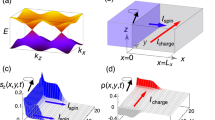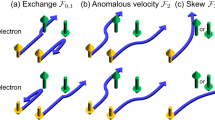Abstract
One of the hallmarks of spintronics is the control of magnetic moments by electric fields enabled by strong spin–orbit interaction (SOI) in semiconductors. A powerful way of manipulating spins in such structures is electric-dipole-induced spin resonance (EDSR), where the radio-frequency fields driving the spins are electric, not magnetic as in standard paramagnetic resonance. Here, we present a theoretical study of EDSR for a two-dimensional electron gas in the presence of disorder, where random impurities not only determine the electric resistance but also the spin dynamics through SOI. Considering a specific geometry with the electric and magnetic fields parallel and in-plane, we show that the magnetization develops an out-of-plane component at resonance that survives the presence of disorder. We also discuss the spin Hall current generated by EDSR. These results are derived in a diagrammatic approach, with the dominant effects coming from the spin vertex correction, and the optimal parameter regime for observation is identified.
This is a preview of subscription content, access via your institution
Access options
Subscribe to this journal
Receive 12 print issues and online access
$209.00 per year
only $17.42 per issue
Buy this article
- Purchase on Springer Link
- Instant access to full article PDF
Prices may be subject to local taxes which are calculated during checkout

 .
.

Similar content being viewed by others
References
Awschalom, D. D., Loss, D. & Samarth, N. (eds) Semiconductor Spintronics and Quantum Computation (Springer, Berlin, 2002).
Zutic, I., Fabian, J. & Sarma, S. D. Spintronics: fundamentals and applications. Rev. Mod. Phys. 76, 323–410 (2004).
Dresselhaus, G. Spin-orbit coupling effects in zinc blende structures. Phys. Rev. 100, 580–586 (1955).
Rashba, E. I. Properties of semiconductors with an extremum loop. Sov. Phys. Solid State 2, 1109–1122 (1960).
Bell, R. L. Electric dipole spin transitions in InSb. Phys. Rev. Lett. 9, 52–54 (1962).
Melnikov, V. I. & Rashba, E. I. Influence of impurities on combined resonance in semiconductors. Sov. Phys. JETP 34, 1353–1358 (1972).
Dobrowolska, M. et al. Far-infrared observation of the electric-dipole spin resonance of donor electrons in Cd1−xMnxSe . Phys. Rev. B 29, 6652–6663 (1984).
Merkt, U., Horst, M., Evelbauer, T. & Kotthaus, J. P. Cyclotron and spin resonance in electron inversion layers on InSb. Phys. Rev. B 34, 7234–7245 (1986).
Kato, Y. K., Myers, R. C., Gossard, A. C. & Awschalom, D. D. Coherent spin manipulation without magnetic fields in strained semiconductors. Nature 427, 50–53 (2004).
Rashba, E. I. & Efros, Al. L. Efficient electron spin manipulation in a quantum well by an in-plane electric field. Appl. Phys. Lett. 83, 5295–5297 (2003).
Schulte, M., Lok, J. G. S., Denninger, G. & Dietsche, W. Electron spin resonance on a two-dimensional electron gas in a single AlAs quantum well. Phys. Rev. Lett. 94, 137601 (2005).
Edelstein, V. M. Space dispersion feature of the conduction electron spin resonance in two-dimensional electron systems caused by absence of ‘up-down’ symmetry. J. Phys. C 5, 2603–2618 (1993).
Erlingsson, S. I., Schliemann, J. & Loss, D. Spin susceptibilities, spin densities and their connection to spin-currents. Phys. Rev. B 71, 035319 (2005).
D’yakonov, M. I. & Perel’, M. I. Possibility of orienting spins with current. JETP Lett. 13, 467–469 (1971).
Murakami, S., Nagosa, N. & Zhang, S. C. Dissipationless quantum spin current at room temperature. Science 301, 1348–1351 (2004).
Sinova, J. et al. Universal intrinsic spin Hall effect. Phys. Rev. Lett. 92, 126603 (2004).
Kato, Y. K., Myers, R. C., Gossard, A. C. & Awschalom, D. D. Observation of the spin Hall effect in semiconductors. Science 306, 1910–1913 (2004).
Sih, V. et al. Spatial imaging of the spin Hall effect and current-induced polarization in two-dimensional electron gases. Nature Phys. 1, 31–35 (2005).
Salis, G. et al. Electrical control of spin coherence in semiconductor nanostructures. Nature 414, 619–622 (2001).
Miller, J. B. et al. Gate-controlled spin-orbit quantum interference effects in lateral transport. Phys. Rev. Lett. 90, 076807 (2003).
Rashba, E. I. & Efros, Al. L. Orbital mechanisms of electron spin manipulation by an electric field. Phys. Rev. Lett. 91, 126405 (2003).
Kato, Y. et al. Gigahertz electron spin manipulation using voltage-controlled g-tensor modulation. Science 299, 1201–1204 (2003).
Elzerman, J. M. et al. Single-shot read-out of an individual electron spin in a quantum dot. Nature 430, 431–435 (2004).
Kroutvar, M. et al. Optically programmable electron spin memory using semiconductor quantum dots. Nature 432, 81–84 (2004).
Golovach, V. N., Khaetskii, A. & Loss, D. Phonon-induced decay of the electron spin in quantum dots. Phys. Rev. Lett. 93, 016601 (2004).
Schliemann, J., Loss, D. & Westervelt, R. M. Zitterbewegung of electronic wave packets in III-V zinc-blende semiconductor quantum wells. Phys. Rev. Lett. 94, 206801 (2005).
Loss, D. & DiVincenzo, D. P. Quantum computation with quantum dots. Phys. Rev. A 57, 120–126 (1998).
D’yakonov, M. I. & Perel’, V. I. Spin relaxation of conduction electrons in noncentrosymmetric semiconductors. Sov. Phys. Solid State 13, 3023–3026 (1972).
D’yakonov, M. I. & Perel’, V. I. in Optical Orientation (eds Meier, F. & Zakharchenya, B.) (Elsevier, Amsterdam, 1984).
Inoue, J., Bauer, G. E. W. & Molenkamp, L. W. Suppression of the persistent spin Hall current by defect scattering. Phys. Rev. B 70, 041303 (2004).
Mishchenko, E. G., Shytov, A. V. & Halperin, B. I. Spin current and polarization in impure two-dimensional electron systems with spin-orbit coupling. Phys. Rev. Lett. 93, 226602 (2004).
Dimitrova, O. V. Spin-Hall conductivity in a two-dimensional Rashba electron gas. Phys. Rev. B 71, 245327 (2005).
Chalaev, O. & Loss, D. Spin-Hall conductivity due to Rashba spin-orbit interaction in disordered systems. Phys. Rev. B 71, 245318 (2005).
Engel, H.-A., Halperin, B. I. & Rashba, E. I. Theory of spin Hall conductivity in n-doped GaAs. Phys. Rev. Lett. 95, 166605 (2005).
Edelstein, V. M. Spin polarization of conduction electrons induced by electric current in two-dimensional asymmetric electron systems. Solid State Commun. 73, 233–235 (1990).
Cohen-Tannoudji, C., Diu, B. & Laloe, F. Quantum Mechanics (Wiley, New York, 1977).
Rammer, J. Quantum Transport Theory (Perseus Books, Reading, Massachusetts, 1998).
Edelstein, V. M. Band-spin-orbit-energy effects in conductivity of two-dimensional weakly disordered semiconductor systems. J. Phys. C 7, 1–18 (1995).
Abragam, A. The Principles of Nuclear Magnetism (Clarendon, Oxford, 1961).
Acknowledgements
We thank O. Chalaev, J. Lehmann, D. Bulaev, W. Coish, S. Erlingsson, D. Saraga, and D. Klauser for discussions. This work was supported by the Swiss NSF, the NCCR Nanoscience, EU RTN Spintronics, DARPA, and ONR.
Author information
Authors and Affiliations
Corresponding authors
Ethics declarations
Competing interests
The authors declare no competing financial interests.
Rights and permissions
About this article
Cite this article
Duckheim, M., Loss, D. Electric-dipole-induced spin resonance in disordered semiconductors. Nature Phys 2, 195–199 (2006). https://doi.org/10.1038/nphys238
Received:
Revised:
Accepted:
Published:
Issue Date:
DOI: https://doi.org/10.1038/nphys238
This article is cited by
-
Combined Magneto-Electric Spin Resonance of Impurity Ho Ions in Synthetic Forsterite
Applied Magnetic Resonance (2014)
-
Ballistic spin resonance
Nature (2009)
-
Snapshots of spins separating
Nature Physics (2008)
-
Measurement of Rashba and Dresselhaus spin–orbit magnetic fields
Nature Physics (2007)
-
Electric fields drive spins
Nature Physics (2006)



